Retaining Structures
One of the purposes of retaining structures is to create large bodies of water, or reservoirs, that have a variety of functions, including land irrigation, power generation, water supply and flood control.
The retaining structures used to build reservoirs are called dams and dikes. A dam is built on the riverbed; it serves to hold back water and raise the water level of the resulting reservoir. Dikes are often built to increase a dam's effectiveness by preventing water from leaving the reservoir through secondary valleys.
There are close to 6,000 retaining structures of various sizes in Québec. The Ministère du Développement durable, de l'Environnement et des Parcs owns most of them; Hydro-Québec owns and operates only one out of 10 such structures.
Other dam owners, including municipalities, outfitters and companies like Alcan, are also involved in dam and dike operation, in addition to water management of the related reservoirs.
Large dams
According to the definition provided by the International Commission on Large Dams (ICOLD), the term "large dam" refers to
- any dam over 15 metres in height from the lowest point of the foundation to the crest, or
- any dam between 5 and 15 metres in height with a reservoir volume of more than 3 million cubic metres.
There are about 45,000 large dams in the world. Over half are used exclusively for irrigating agricultural land. About one out of four generate electricity.
Of Canada's 793 large dams, 226, or just over one quarter, are located in Québec. Hydro-Québec operates more than 550 dikes and dams.
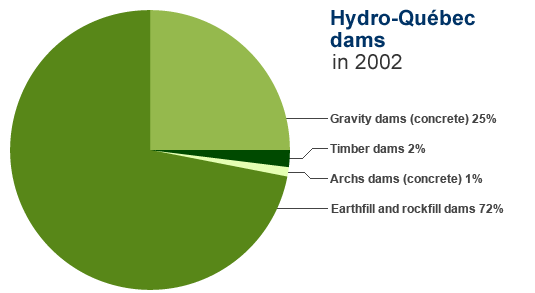

Dam inspection
Hydro-Québec continually monitors the condition of its facilities. However, certain underwater portions of its dams are difficult to inspect. These dam facings are visually inspected by a diver or an underwater robot equipped with a camera.
ROV-3, an underwater robot designed for the needs of hydroelectric dam operators, makes inspection of hard-to-reach places a safer job for divers.
Earthfill dam
A dam is considered an earthfill dam when more than half its fill volume is composed of compacted fine materials.
The building of such a dam is dependent on the availability of raw materials.
Rockfill dam
Till is the loose sediment deposited by glaciers, and it's the perfect material for making a dam watertight. It forms the core of most rockfill dams owned by Hydro-Québec, including some of the retaining structures in the La Grande complex.

Gravity dam (concrete)
The stability of this concrete dam is ensured by the structure's weight.

Arch dam (concrete)
Daniel-Johnson dam: A feat of engineering

Reservoir surface area (Manicouagan): 1,973 km2
- 5th largest reservoir in the world
Height: 214 metres
- Highest multiple-arch-and-buttress dam in the world
- 28th highest dam in the world (all categories)
- 2nd highest dam in Canada
Crest length: 1.3 kilometres
This multiple-arch-and-buttress dam is truly unique. Inaugurated in 1969, it was named after Québec's Premier at the time, Daniel Johnson. Its reservoir is four times the size of the Island of Montréal. Its construction, spread over a 10-year period, required 2.2 million cubic metres of concrete, the equivalent of a regular sidewalk linking the North and South Poles. In 2000, Canada Post issued a stamp in honor of this structure. The reservoir supplies water to Manic-5 and Manic-5-PA power stations.
A concrete dam with a convex arch facing upstream which transmits the greater part of the force of water to the lateral abutments.

Dike
A dam characterized by its length, designed to inhibit water movement (currents or tides) or to hold back water.
Timber dam
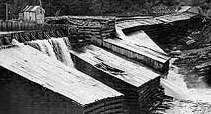 East Angus dam, belonging to Brompton Pulp and Paper (1950)
East Angus dam, belonging to Brompton Pulp and Paper (1950)
A dam built by assembling timber to form stone-filled cribs.
 Hydro-Québec dams
Hydro-Québec dams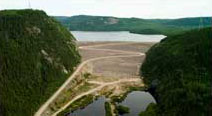 Manic-3 dam
Manic-3 dam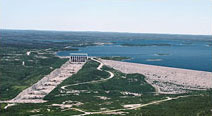 The storage capacity of the rockfill dam at Robert-Bourassa reservoir–61.7 billion cubic metres–
The storage capacity of the rockfill dam at Robert-Bourassa reservoir–61.7 billion cubic metres–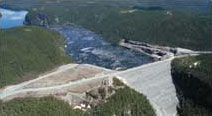 Rising 171 metres in the air, the rockfill dam at Sainte-Marguerite-3 is the highest dam of its kind
Rising 171 metres in the air, the rockfill dam at Sainte-Marguerite-3 is the highest dam of its kind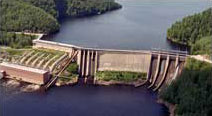 Trenche dam
Trenche dam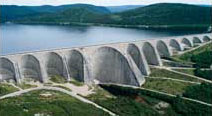 Daniel-Johnson dam: A feat of engineering
Daniel-Johnson dam: A feat of engineering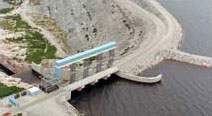 Dike QA-8 along La Grande 4 reservoir
Dike QA-8 along La Grande 4 reservoir 
